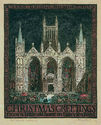
19th, 20th & 21st Century Fine Prints
707-546-7352 · fax 707-546-7924 · web: www.annexgalleries.com · email: artannex@aol.com
Elbert Peets Biography
Elbert Peets
American
1886–1968
Biography
Elbert Peets was born in Hudson, Ohio, on May 5, 1886. He graduated from Central High School in Cleveland in 1905 and from Western Reserve University in 1912. While at college he worked with H.U. Horvath, a landscape architect and nurseryman. He earned the degree of Master of Landscape Architecture at Harvard in 1915, teaching horticulture during his time there. After Harvard he began to work for the firm of Pray, Hubbard, and White, making plans for land subdivisions. In 1916 he published Practical Tree Repair, a how-to manual.
Peets worked as a civic planner and landscape architect working on projects such as Kohler, Wisconsin and Wyomissing Park, a suburb of Reading, Pennsylvania. In 1922, along with Werner Hegemann, he published 'Civic Art, the American Vitruvius' In 1923 he also began an independent practice in Cleveland and in 1933 Peets joined the Cleveland City Planning Commission. In 1935 Peets went to Washington to work with the U.S. Farm Resettlement Administration as the principle town planner of Greendale, Wisconsin. In 1938 he became the Chief of the Site Planning Section for the U.S. House Authority. At the end of World War II he accepted a position as consultant for the Federal Planning and Housing Authority and for the Public Housing Authority.
From 1946 to 1947 Peets was a designer and consulting to Mr. Phillip Klutznick of American Community Builders, where he developed plans for the town of Park Forest, Illinois, one of the nation's first post WWII planned communities. From 1950 to 1954 he served a member of the Fine Arts Commission in Washington, D.C. He was also a consultant to the National Capital Park and Planning Commission. In the 1950s Elbert Peets lectured at Harvard and Yale, and designed a number of monuments and war memorials in partnership with the sculptor Felix de Weldon. In the 1960s failing health forced him to retire to Austinburg, Ohio. He died in 1968.

